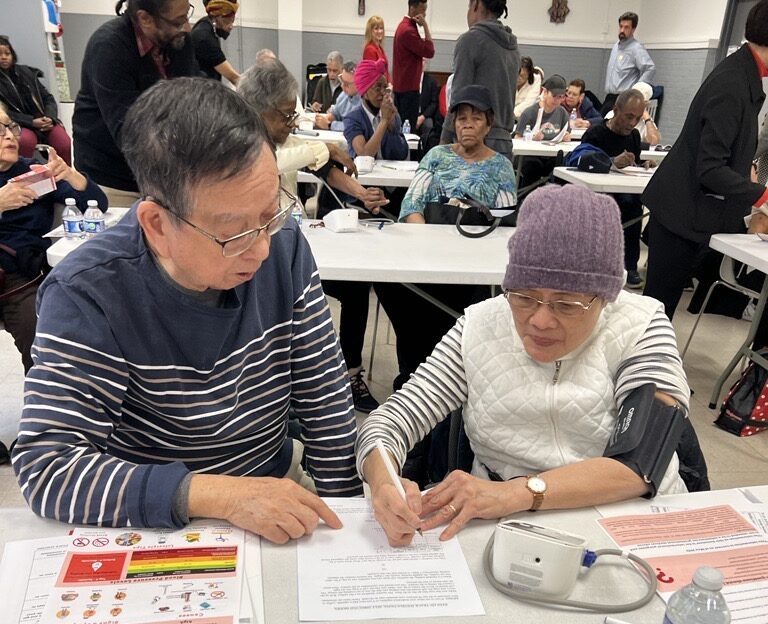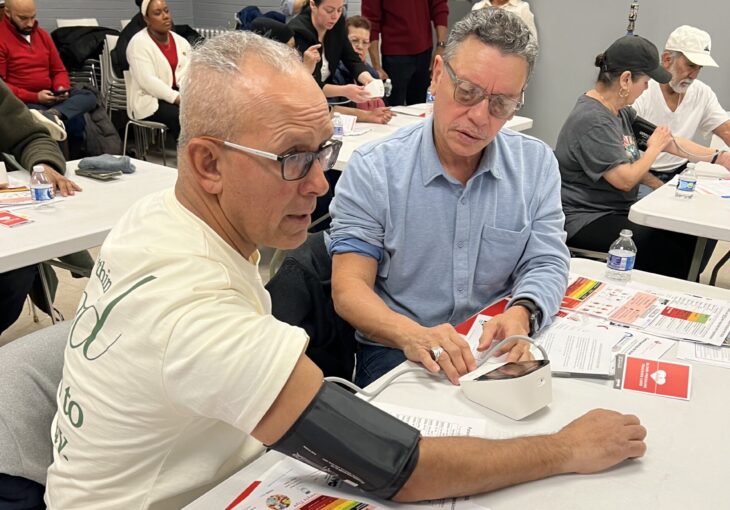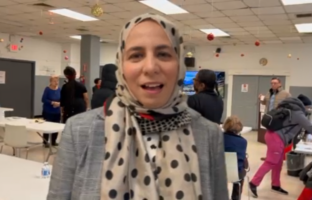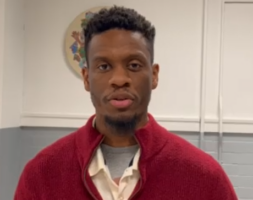By Diego Ortiz Quintero

Lorraine A. Cortes-Vasquez, commissioner of the New York City Department for the Aging (left) speaking with representatives from Carter Burden and the American Heart Association.
On Wednesday, February 21, 2024, the Carter Burden/Leonard Covello Older Adult Program in East Harlem (312 East 109th Street) hosted a high blood pressure workshop and self-measurement demonstration for its community. In the audience were more than 25 members of the center’s older adult program, along with leaders from the American Heart Association, the New York City Department for the Aging, the New York City Department of Health and Mental Hygiene, and the High Blood Pressure Coalition: Take the Pressure Off, NYC!
“I had the pleasure to come to Carter Burden for this wonderful blood pressure demonstration courtesy of the American Heart Association, who gave us these monitors so that people can have the power to control their own health information between doctor’s visits,” said Lorraine A. Cortes-Vasquez, commissioner of the New York City Department for the Aging. “This will help older adults inform their doctor and stay informed in between visits.”
The workshop was part of the official launch of a new collaboration between the American Heart Association and the New York City Department for the Aging that will place self-measurement blood pressure cuffs in 10 older adult centers across the city.
“This has been tremendous. We’re super happy to be collaborating with New York City Department for the Aging to help ensure that each older adult that walks through the doors here and the other 10 older adult centers will have more access to measuring and will be able to take that back to their medical provider and have a better decision-making progress with their provider,” said Trevor Martindale, Community Impact Director, American Heart Association. “We’re excited to do this and continue to do this with older adult centers around the city.
Why is it important to measure between visits?

Miguel Perez learning how to use the monitor and cuff.
High blood pressure (hypertension) is often called the silent killer because it may show no symptoms but may increase your risk for heart disease and stroke. According to the Department of Health and Mental Hygiene, more than one in four adults in New York City is living with high blood pressure, and many more don’t even know they have it.
High blood pressure is a contributing factor to major health conditions. Improving the diagnosis, treatment, and control of hypertension is critical to improving the cardiovascular health of all New Yorkers.
Miguel Perez, 66, is one of the older adults who attended the workshop. He asked a lot of questions during the workshop and says this helped him to better understand what causes high blood pressure and how you can control it.
“This (blood pressure monitor) can help me save my own life, improve my way of eating and allow me to do whatever needs to be done to better my health,” Perez said.
Click on the linked images above to watch their video interviews!
According to Pulwasha Iftikar, Hypertension Initiative Manager, Take the Pressure Off, NYC, the citywide hypertension initiative from the Department of Health, the purpose of and goal of this program is to build awareness among older adults to reduce the prevalence of high blood pressure and also share the tips and tricks to how they can effectively manage their own blood pressure.
“Blood pressure is the so-called silent killer because you can die if your blood pressure becomes too high. Self-monitoring is a good way for you to keep control of your blood pressure,” said Laverne Snipes, who works for the Aging Wellness Unit at the Department for the Aging. “I have high blood pressure and I never self-monitored myself until I went to the doctor and was told I needed to do that. It’s very important to have your pressure checked on a regular basis.”
Snipes says a program like this one is very important because everyone does not have access to monitors at home.
“This way you can come to the center and self-monitor yourself at the center on a regular basis. The seniors need to know what their numbers are because once you know what your numbers are you can take it from there and make lifestyle changes,” she said.
Agnes Mak, Senior Director, from the Department for the Aging says this program can help participants maintain a good quality of life. Mac says one participant told her she would be coming every day to attend her activities, have lunch and measure her blood pressure. The participant plans to start monitoring her numbers on the cards provided in a package during the workshop and will bring it with her to her next doctor’s visit to discuss with her physician.
Blood pressure: What do the numbers mean and why do they matter?

According to the American Heart Association and American College of Cardiology, a normal blood pressure for adults is a systolic measurement of less than 120 mmHg and a diastolic reading under 80 mmHg. Blood pressure is elevated when the systolic consistently reaches 120-129 mmHg and the diastolic is less than 80 mmHg. It is considered stage 1 hypertension when systolic blood pressure consistently hits 130-139 mmHg or the diastolic reaches 80-89 mmHg, and stage 2 hypertension when the readings consistently reach 140 mmHg or 90 mmHg or higher, respectively. Blood pressure readings that suddenly exceed 180 systolic and/or 120 diastolic are considered a hypertensive crisis that requires immediate medical attention.
Making lifestyle changes is the first step. This can include losing weight if needed, becoming more physically active, limiting alcohol consumption, managing stress, quitting smoking if the person smokes and eating a healthier diet.
The American Heart Association recommends home monitoring for all people with high blood pressure to help the health care professional determine whether treatments are working. Home monitoring, or self-measured blood pressure, is not a substitute for regular visits to your physician. If you have been prescribed medication to lower your blood pressure, don’t stop taking your medication without consulting your health care professional, even if your blood pressure readings are in the normal range during home monitoring.
Home blood pressure monitoring may be especially useful for:
- Anyone diagnosed with high blood pressure, also known as hypertension.
- Individuals starting high blood pressure treatment to determine its effectiveness.
- People requiring closer monitoring, especially individuals with risk factors for high blood pressure and/or conditions related to high BP.
- Pregnant women experiencing pregnancy-induced hypertension and/or preeclampsia.
- Evaluating potentially false readings, like:
- People who only have high readings at the health care professional’s office (“white coat” hypertension).
- People who only have high readings at home but not at the health care professional’s office (“masked” hypertension).
Did you see this? Thank you NY1 Around the Boroughs for covering this workshop and program launch.
| Locations |
|
Neighborhood SHOPP Casa Boricua Older Adult Center 910 East 172nd Street Bronx, NY 10460
|
| Castle Hill Glebe Senior Center
Shipping address different than OAC location Castle Hill YMCA 2 Castle Hill Avenue Bronx, NY 10473
|
| West Brighton Neighborhood Center
230 Broadway Staten Island, NY 10310
|
| New Dorp Beach Friendship Club OAC
128 Cedar Grove Avenue Staten Island, NY 10306
|
| PSS Manhattanville
Older Adult Center 530 W 133rd St. New York, NY 10027
|
| Rosetta Gaston Neighborhood
Older Adult Center 460 Dumont Ave, Brooklyn, NY 11212
|
| PSS Harlem at Oberia
Dempsey Multi-Service Center 127 West 127th Street, Room 125 New York, NY 10027
|
| Carter Burden Center- Leonardo Covello OAC
312 East 109th street New York, NY 10029
|
| Catholic Charities- Peter J. Dellamonica
Older Adult Center 23-11 31st Road Astoria, NY 11106
|
| Grace Agard Harewood-
Fort Greene Council Older Adult Center 966 Fulton Street Brooklyn, NY 11238
|




